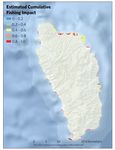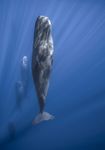Mapping Ocean Wealth in Dominica - Overview
←
→
Page content transcription
If your browser does not render page correctly, please read the page content below
Mapping Ocean Wealth
in Dominica
Overview
Dominica, sometimes called “The Nature Island” is nation
rich in natural resources. It is known for its lush rainfor-
ests, mountainous terrain, towering waterfalls like Trafal-
gar Falls, and geothermal activity, which is responsible for
the volcanically heated Boiling Lake in Morne Trois Pitons
National Park. Its diverse marine habitats draw divers and
whale watchers alike, while its inland rainforests and large
national parks provide many opportunities for birdwatch-
ing. The country is recovering from the impacts of Hurri-
cane Maria in 2017, and in doing so is striving to become
a climate resilient nation. In Dominica, many people rely
on reef fisheries for food and income, and there has been
an increasing recognition in the region to better manage
these resources, especially in the face of climate change.
The value of coastal and marine resources are often over-
looked, but can be considerable as highlighted below.
The maps and statistics highlighted here are only a brief
synthesis but point to the utility of both enumerating and
mapping tourism value. Such maps and numbers may be
critical in building a Blue Economy in the region, providing
guidance on the location of key national assets, enabling
such assets to be fully incorporated into planning, empow-
ering communities and other users.
Photo Credit: Romain Barats
Coral Reef Tourism
Dominica is considered one of the top diving destinations in
the Caribbean, and diving and snorkeling activities on coral
reefs are estimated to bring in over $11 million in tourism
expenditures annually. The highest values can be found
near the Port of Soufriere in the southwest, where there at
least 17 known dive sites within 5km of the port. This high-
ly used area includes Champagne Reef, where divers and
·
Ripaton
Beach snorkelers can swim among bubbles from thermal vents
and the nearby volcano. Scotts Head, and the Volcanic
Crater, both located within the Soufriere/Scotts Head Ma-
rine Reserve, are additional high value coral reefs, drawing
in values of over $200k per ha per year. Smaller coral reef
Mero
·
Roseau
Champagne Reef
·
Scott’s Head
·tourism hot spots can be found off the coast of Mero, near
the Maggie’s Point dive sites, as well as in Portsmouth off
of Ripaton Beach and Secret Bay, where snorkelers can
access underwater coral habitats from shore.
Nature-Dependent Beaches
The models show a small but intense nature-dependent
beach-going hot spot around Secret Beach and Tibay
Beach. Secret Beach is only accessible by boat and offers
white sand and calm swimming waters in a shallow la-
goon. Tibay Beach also secluded (only accessible through
resort or by water) is a popular setting off point for kay-
aking and paddleboarding. These natural values of these
beaches are estimated to generate over $1.8 million/year
in tourism spending combined. Further south, Champagne
Beach is another hot spot. The beach’s close proximity to
the volcano means that visitors can enjoy naturally warm
and effervescent pools created by nearby hot springs. It is
Tibay Beach &
·
Secret Beach
Attracting Devices (FADS) which can be quite far offshore.
Several of the tour operators offer both fishing and whale/
dolphin watching. Passengers aboard these trips generally
fish for barracuda, sailfish, dolphin (mahi mahi), blue and
white marlin, wahoo, yellowfin, and skipjack tuna.
Wildlife
In Dominica, the bird-watching community have recorded
212 bird species from almost 18,000 reported observa-
tions. Dominica is home to two species of bird endemic
to the island, the Jaco (red-necked amazon) and imperial
amazon, as well as 21 other species endemic to the region.
Birdwatching hot spots can be found along the western
Champagne
Beach · side of the island, coincident with popular tourism desti-
nations, but also within the country’s two inland national
parks. Morne Diablotin National Park, a protected area and
an important bird watching area, and also home to the
Syndicate Nature Trail has had 69 species recorded by us-
ers of the eBird platform, and high levels of visitation (233
birder observer days).
also close to popular snorkeling and diving locations. Com-
pared to other Eastern Caribbean countries, Dominica is Dominica has one of the largest boat-based whale-watch-
not as well known for its beaches; however, the black sand ing industries in the Caribbean generating almost $2million
beaches associated with the island’s volcanoes constitute in direct tourism expenditures per year. The country’s deep
a unique tourism draw. offshore canyons are home to sperm whales, arguably the
industry’s largest draw, but also Cuvier’s beaked whales,
Recreational Fishing short-finned pilot whales, false killer whales, various spe-
cies of dolphin, and seasonally, humpback and Bryde’s
We detailed the activities of six known charter fishing op- whales. The models show high levels of whale watching
erators in Dominica and found that this activity generates intensity coincident with the canyons off the western coast
over $400k in direct tourism spending every year. Most of the island.
tours leave from Roseau and fishing activities are concen-
trated along the west coast of the island, mostly towards
the south. In some cases, operators take fishers to Fishest biomass values for all species can be found in the coral
reefs farthest from shore off the northeast side of the is-
land, especially between Wesley and Woodford Hill. There
* are also areas of high biomass for all surveyed species on
the nearshore reef areas near Petite Soufriere (central east
coast). These areas of high biomass are, as expected, co-
incident with areas of lower fishing impact. Fishing impact
across the rest of the country’s reef is high.
The models show opportunities for increasing the biomass
of snapper-grouper complex in several locations, most no-
tably off of Scotts Head on the southwest tip of the is-
land and on the offshore reefs in the Northeast. Reducing
fishing impacts on these reefs has the potential to nearly
double snapper-grouper stocks. Any such changes could
very likely have positive outcomes for the diving industry
already active in this area, in addition to the benefits for
fishers and the habitats on which they rely. Opportunities
for increasing parrotfish populations through increase in
coral cover can be found in several location on the north-
east side of the island, especially in the reef areas around
Portsmouth and off of Baroui.
Birdwatching effort weighted by species importance score. Score is based
on four metrics applied to each species (endemism, threat status, rarity,
··
and charisma
Woodford
Hill
Wesley
·
Petite Soufriere
A Note on Covid-19
The pandemic has had a dramatic
impact on tourism, and will likely
have also impacted patterns and
effort in fisheries. The longer-term
impacts are too early to predict. It
is likely that national dependence
on reef fisheries may have in-
creased, raising the urgency for ac-
Coral Reef Fisheries tive management to ensure long-
term stability of these. For tourism,
it seems likely that the natural val-
The coral reefs of Dominica support an estimated mean ues, especially in low density tour-
ism areas, will prove a key driver in
value of 5 g/ m2 for snapper-grouper species and 4 g/m2 tourism recovery.
for parrotfish (46 g/m2 for all surveyed species). The high-Highlighted Statistics*
On reef tourism such as snorkeling and
SCUBA draws over 19,000 visitors and
over $11 Million in spending, annually
Calm, turquoise waters, lush vegetation
and other natural features of Domini-
ca beaches are responsible for almost
28,000 visitors and almost $9 Million
in annual spending
Dominica has at least 6 sportfish-
ing charter operators. Tourists spend
$360,000 on sportfishing tours annu-
ally
Dominica has at least 7 whale/dolphin
watching charter operators. Tourists
spend at least $1.8 Million on these
tours annually
Dominica’s reefs support 46 g/m2 in
fishable biomass when accounting for
all surveyed species. The average pre-
dicted gain in snapper-group biomass
under reduced fishing measures across
all reef areas in 58%
Dominica's Contribution to Current Coral Reef Fish Biomass for
Regional On-Reef Tourism All Surveyed Species
Expenditures
60
St. Kitts &
$11,382,075 Dominica Nevis
50
St. Vincent
40 Saint Lucia & the
Grenada Grenadines
g/m2
30
$106,936,107
20
10
Dominica Other Countries in Study** 0
*Models and statistics were built to reflect values for the period immediately preced-
ing Covid-19 (2019). Models have been built from multi-year summaries up until this
date. See technical reports for details
** Grenada, Saint Lucia, St. Kitts & Nevis, and St. Vincent and the Grenadines
About This Project
The Global Environment Facility (GEF), the Organisation of
Eastern Caribbean States (OECS) Commission, in partnership
with the World Bank, is implementing the Caribbean Region-
al Oceanscape Project (CROP) to improve systems and put rel-
evant structures in place in an effort to foster a Blue Economy
and to promote greater consideration of the ecosystem func-
tions and services which the ocean provides for member states.
The project timeline was October 2017 - December 2021.
Under this project, The Nature Conservancy used the Mapping
Ocean Wealth approach to develop ecosystem service models
and maps at the scale of the Eastern Caribbean in support of
CROP. The figures and statistics referenced in this summary
are derived from the technical reports and datasets found at:
·
Scott’s Head oceanwealth.org/project-areas/caribbean/CROP
CROP Project Overview: https:/oecs.org/en/crop
Map Viewer: maps.oceanwealth.org/oecsYou can also read



























































